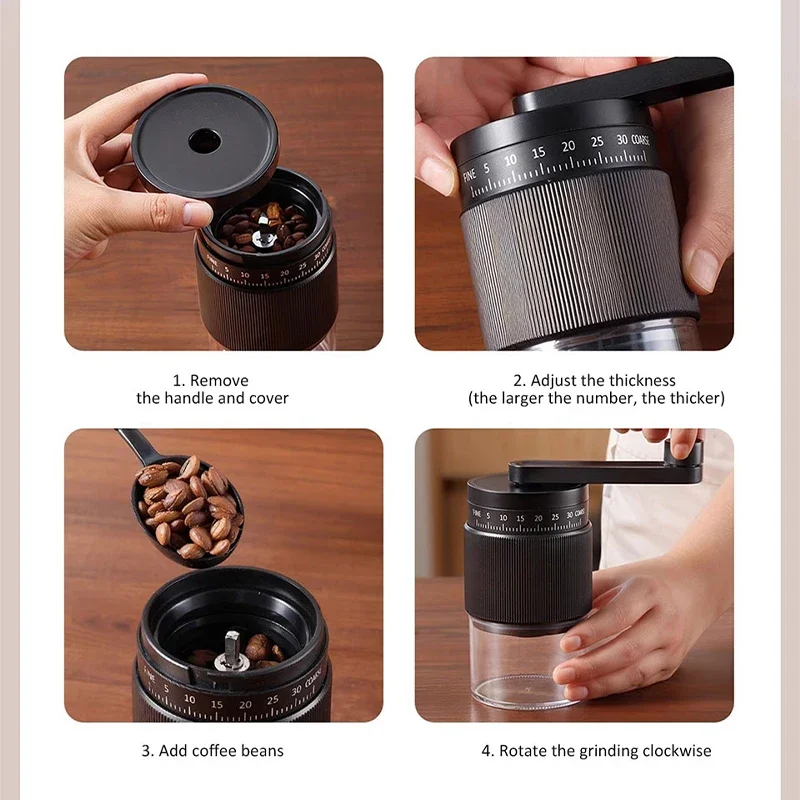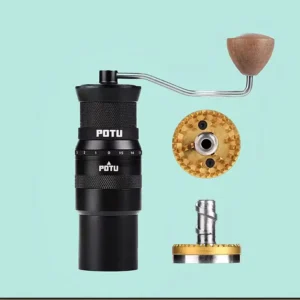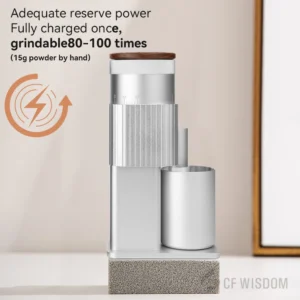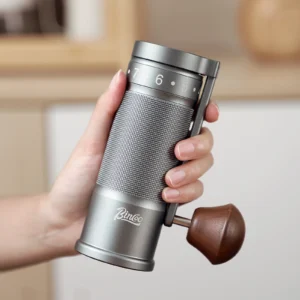Manual Coffee Grinders: The Foundation of Exceptional Home Brewing
For passionate coffee enthusiasts, the journey to a perfect cup begins long before the brewing process. It starts with properly ground coffee beans, which is why manual coffee grinders have become essential tools in the specialty coffee world. The quality of your grind directly impacts extraction efficiency and ultimately determines the flavor profile of your brew.
When coffee particles are uniform in size, water extracts the flavors evenly, resulting in a balanced cup. Inconsistent particles lead to under-extraction from larger chunks and over-extraction from tiny fragments – creating both sour and bitter notes simultaneously.
The heart of any quality grinder is its burr system, and choosing between flat and conical burrs significantly impacts your daily grinding experience and coffee taste. Unlike electric grinders where motor power compensates for design differences, manual grinders require you to provide the force, making burr selection even more critical.
This guide aims to unravel the complex differences between flat and conical burrs specifically in manual grinders, helping you:
- Understand the mechanics behind different burr designs
- Compare grinding performance and effort requirements
- Match burr types to your preferred brewing methods
- Make an informed decision for your coffee journey
For those new to specialty coffee, unlocking superior coffee begins with understanding proper grinding. Many coffee lovers discover significant flavor improvements when switching from blade to manual burr grinders, but the burr shape debate adds another layer of complexity to finding your ideal manual coffee burr grinder.
Understanding Burrs: The Heart of Your Manual Grinder
Coffee burrs are specialized grinding surfaces designed to crush coffee beans into consistent particles. Unlike blade grinders that randomly chop beans, burrs methodically crush them between two precision-engineered surfaces, one stationary and one rotating.
This crushing action creates remarkably consistent coffee grounds – the foundation of even extraction and balanced flavor. The design of these burrs directly influences:
- Particle size consistency
- The physical effort required for grinding
- Flavor clarity and body in your cup
- Heat generation during grinding
- Retention of coffee grounds within the grinder
Burrs typically come in two materials: steel and ceramic. Steel burrs are sharper and more precise but may dull slightly faster. Ceramic burrs remain sharp longer but can be more brittle if beans contain small stones. Both materials perform exceptionally in quality grinders, with design and manufacturing precision being more important factors than material alone.
The most significant decision when choosing a manual grinder isn’t the burr material but rather the fundamental burr shape: flat or conical. This choice affects everything from grinding effort to flavor profile.
Understanding why burr grinders make a difference in coffee quality helps appreciate the nuances between burr designs. For those preferring durability and heat resistance, ceramic burr coffee grinders offer excellent performance with proper care.
Conical Burrs in Manual Grinders: Characteristics and Performance
Conical burrs feature a cone-shaped inner burr that fits inside a hollow, ring-shaped outer burr. This design creates a vertical grinding path where beans enter from above, get crushed between the burrs, and exit below as ground coffee.
This vertical orientation works exceptionally well for manual grinding because:
- Beans naturally flow downward with gravity
- The grinding action requires less torque (rotational force)
- The design efficiently crushes beans with minimal user effort
Conical burrs typically create a bimodal particle distribution – meaning the grounds contain both the target particle size and a smaller percentage of fines (very small particles). While coffee experts sometimes debate whether this is optimal, these fines can add body and richness to the final cup.
Most manual grinders on the market feature conical burrs, typically ranging from 30mm to 38mm in diameter. Larger burrs generally grind faster but require more space, making the grinder less portable. The sweet spot for most manual grinders is around 38mm – balancing grinding speed with reasonable size.
The grinding experience with conical burrs tends to be smooth and manageable, even for medium-fine to fine grinds. The bean path through conical burrs requires less force to maintain consistent grinding speed, allowing for a more comfortable experience during extended grinding sessions.
For espresso enthusiasts, specialized manual espresso grinders with conical burrs provide the fine consistency needed while remaining manageable to operate by hand.
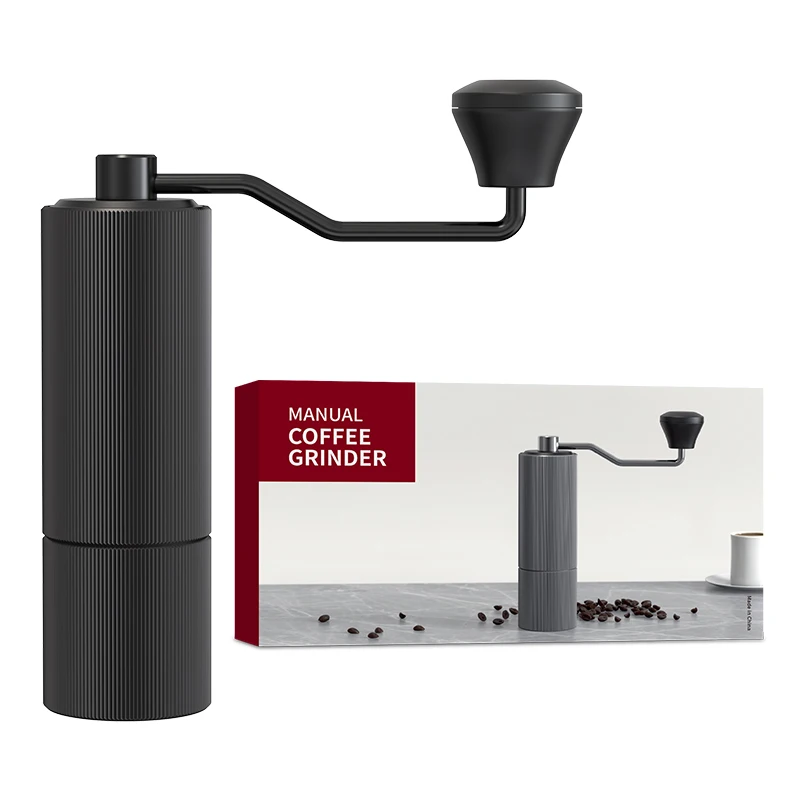
Flat Burrs in Manual Grinders: Characteristics and Performance
Flat burrs consist of two parallel, ring-shaped grinding surfaces with teeth that face each other. Coffee beans enter through the center and travel horizontally outward between the burrs before dropping into the collection chamber.
This horizontal path creates several distinct characteristics:
- Extremely uniform particle size distribution
- Minimal fines production
- Potentially greater clarity in the cup
- Traditionally higher torque requirements
Historically, flat burrs were rare in manual grinders because their design demands more force to operate compared to conical burrs. The horizontal grinding path doesn’t benefit from gravity assistance, and the wider grinding surface creates more resistance during rotation.
However, recent engineering innovations have addressed these challenges through improved bearing systems, optimized cutting teeth patterns, and mechanical advantage through gearing. These advances have made flat burr manual grinders more accessible, though they typically remain in the premium market segment.
The grind profile from flat burrs tends to be more uniform, with fewer fines and a tighter particle distribution. This uniformity can translate to enhanced clarity and brightness in the cup, allowing distinct flavor notes to shine individually rather than blending together.
Coffee enthusiasts seeking the benefits of flat burr grinders for exceptional coffee now have manual options that offer this precision without requiring electric motors. These flat burr hand grinders represent the cutting edge of manual coffee grinding technology.
The Direct Comparison: Flat vs Conical Burrs in Manual Grinders
| Feature | Conical Burrs | Flat Burrs |
|---|---|---|
| Grind Consistency | Good uniformity with some fines | Excellent uniformity with minimal fines |
| Grinding Effort | Moderate; works with gravity | Higher; requires more force |
| Grinding Speed | Moderate to fast | Typically slower in manual grinders |
| Taste Profile | Fuller body, rich mouthfeel | Greater clarity, distinct flavor notes |
| Grind Retention | Very low in quality designs | Low to moderate |
| Static Issues | Minimal | Can be more pronounced |
| Noise Level | Quieter | Slightly louder |
| Size/Portability | More compact designs possible | Generally larger for equivalent performance |
| Price Range | $30-$300 | $200-$500+ |
| Maintenance | Easier cleaning and reassembly | More complex alignment considerations |
The fundamental differences between these burr types create distinct advantages for different brewing scenarios. Conical burrs excel in manual grinders because their design naturally requires less force to operate. When grinding manually, this efficiency becomes particularly important as you’re providing all the power yourself.
The taste difference between these burr types stems from their different particle distribution patterns. Conical burrs produce a slightly wider range of particle sizes, including some fines that contribute body and richness to the cup. Flat burrs create more uniform particles that extract more evenly, often highlighting brighter, clearer flavor notes.
This doesn’t mean one is objectively better – it’s about matching the grinder to your taste preferences and brewing methods. Understanding grind particle uniformity in flat burr systems helps appreciate why some brewers prefer them, while others value the critical impact of burr alignment on consistent performance.
Grinding Experience: The Manual Factor
When choosing a manual grinder, the physical experience of grinding becomes a significant factor. Unlike electric grinders, you’ll interact with your manual grinder daily, making the grinding experience as important as the final results.
Conical burrs offer several experiential advantages:
- Lower torque requirements mean easier grinding, especially for fine settings
- Grinding typically takes 30-60 seconds for a standard brew (depending on burr size)
- The bean path works naturally with gravity
- More forgiving of minor alignment issues
Flat burrs present different characteristics:
- Higher resistance, especially at finer settings
- May require 45-90 seconds for equivalent amounts (in traditional designs)
- Often feature more substantial handles to provide mechanical advantage
- Requires more precise alignment for optimal performance
The ergonomics of the grinder become crucial for enjoyable daily use. Handle length, bearing quality, and grip comfort all affect the grinding experience. Quality manual grinders address these concerns with:
- Extended handles for better leverage
- Smooth-rolling bearings that reduce wobble
- Comfortable grips that prevent slipping
- Stable bases or bodies that remain secure during grinding
For travelers and outdoor enthusiasts, the reduced effort of conical burrs often makes them the preferred choice. However, premium flat burr manual grinders with advanced engineering can offer relatively comfortable grinding experiences for those seeking their specific grind profile.
Finding the right balance between grind consistency and speed in manual grinders depends largely on your patience and physical comfort. Innovations in comfortable manual coffee grinder handles have made daily grinding more enjoyable, particularly in precision manual grinders designed for optimal ergonomics.
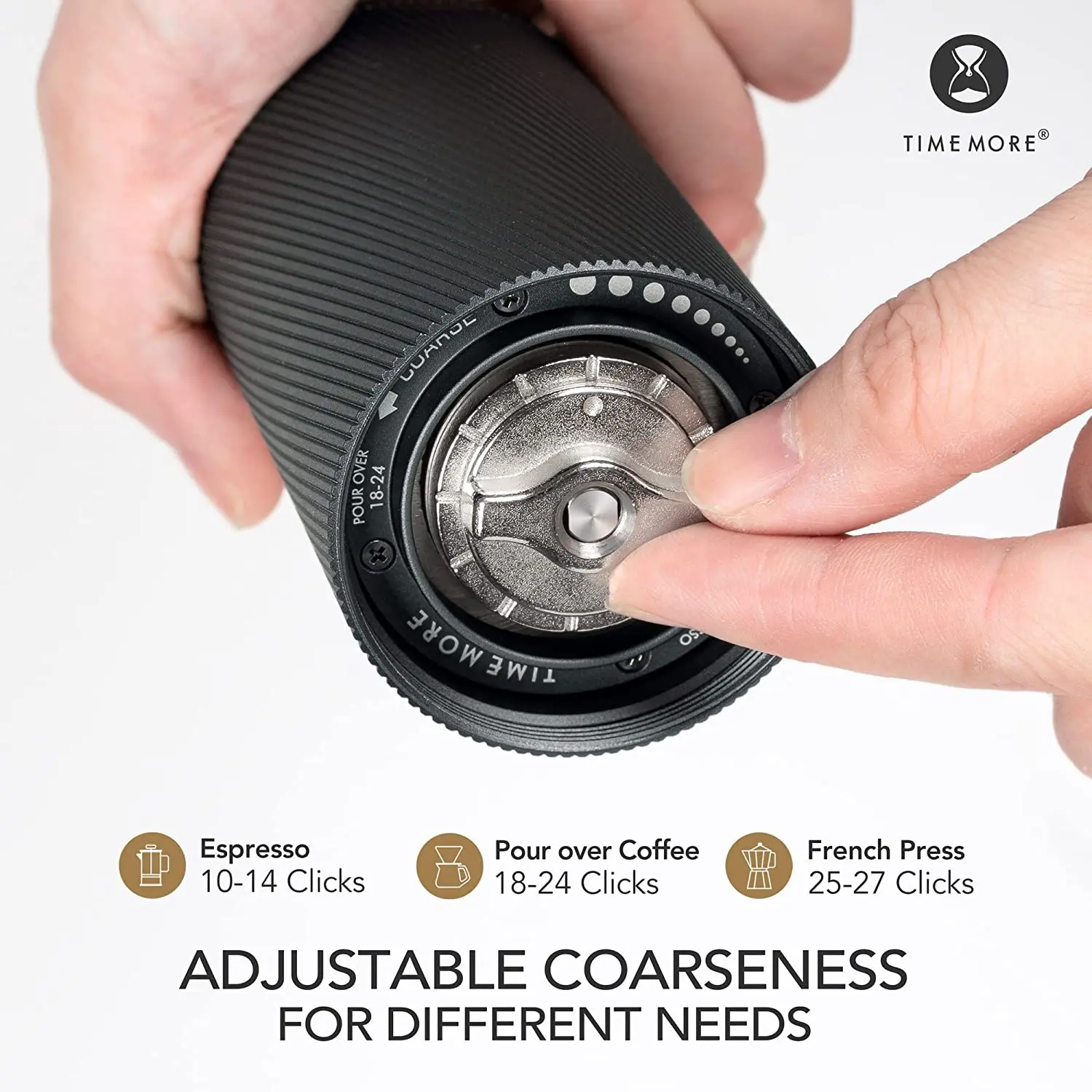
Taste in the Cup: How Burr Type Influences Your Coffee
The particle distribution created by different burr designs directly impacts flavor extraction. When water interacts with coffee grounds, it extracts different compounds at different rates. Uniform particles extract evenly, while varied particle sizes extract at different rates.
Conical burrs typically produce:
– A bimodal distribution with some fines
– Fuller body and mouthfeel
– Rich, complex flavor profiles
– Sometimes described as “traditional” coffee character
– Potentially more forgiving for medium to dark roasts
Flat burrs generally create:
– More uniform particle distribution
– Enhanced clarity and brightness
– More distinct separation of flavor notes
– Often preferred for highlighting unique bean characteristics
– Potentially better for light to medium roasts
Neither profile is inherently superior – they’re simply different. Many specialty coffee professionals prefer flat burrs for pour-over methods where clarity showcases unique bean origins. Others favor conical burrs for espresso, where some fines can enhance crema formation and create rich texture.
Your preferred brewing method interacts significantly with these characteristics. For immersion methods like French press, the filtering process already removes some fines, making conical burrs’ minor inconsistencies less problematic. For precision pour-over, the enhanced clarity from flat burrs might better highlight delicate flavor notes.
Understanding how flat burr uniform extraction influences flavor can help match your grinder to your taste preferences. Espresso enthusiasts often explore specialized manual coffee grinders for espresso to achieve their ideal flavor profile.
Best Use Cases: Matching Burr Type to Your Brewing Style
Different brewing methods benefit from specific grind characteristics, making certain burr types potentially more suitable:
Pour-Over Methods (V60, Kalita, Chemex)
– Ideal Burr: Flat burrs often preferred
– Benefit: Enhanced clarity showcases the bright, delicate notes these methods extract
– Alternative: High-quality conical burrs with minimal fines production also perform excellently
Immersion Methods (French Press, AeroPress)
– Ideal Burr: Both perform well; preference-based
– Benefit: Conical burrs add body; flat burrs enhance clarity
– Consideration: French press filters allow more fines through than paper filters
Espresso
– Ideal Burr: Traditionally conical, but changing with modern preferences
– Benefit: Some fines from conical burrs can enhance crema and body
– Modern Trend: Many espresso enthusiasts now prefer flat burrs for clarity and consistency
Cold Brew
– Ideal Burr: Conical typically preferred
– Benefit: The fuller body complements cold brew’s naturally smooth character
– Consideration: Long extraction time makes minor inconsistencies less problematic
Coffee bean type also influences burr selection. Light roasts, being denser and more difficult to grind, often benefit from the efficiency of conical burrs in manual grinders. Dark roasts, being more brittle, grind easily with either type, making the flavor profile preference more relevant.
Understanding the impact of burr shape on espresso consistency can be particularly helpful for home baristas. For versatility across brewing methods, many coffee enthusiasts choose high-quality hand burr grinders that balance performance characteristics.
Fine Adjustment Hand Grinder, Precision Manual Grinder, Travel Coffee Grinder
Price range: $185.11 through $494.63 Select options This product has multiple variants. The options may be chosen on the product pageHand Burr Grinder, Hand Crank Coffee Grinder, Manual Espresso Grinder, Portable Coffee Grinder
Price range: $262.72 through $300.22 Select options This product has multiple variants. The options may be chosen on the product pageManual Burr Mill, Manual Coffee Grinder Stainless Steel, Manual Coffee Mill Grinder, Mechanical Coffee Grinder
Price range: $127.26 through $130.32 Select options This product has multiple variants. The options may be chosen on the product pageHand Burr Grinder, Manual Coffee Grinder Stainless Steel, Precision Manual Grinder
Price range: $183.64 through $187.52 Select options This product has multiple variants. The options may be chosen on the product page
Maintenance and Longevity: Caring for Different Burr Types
Proper maintenance ensures your manual grinder provides consistent performance for years. The burr type affects cleaning procedures and long-term care requirements.
Cleaning Conical Burrs:
1. Remove the adjustment knob and outer burr (typically twist or unscrew)
2. Brush visible coffee particles from both burrs with a soft brush
3. Use a vacuum with brush attachment for deeper cleaning (optional)
4. Reassemble in reverse order
5. Run a few beans through to resettle the burrs
Cleaning Flat Burrs:
1. Remove the adjustment mechanism according to manufacturer instructions
2. Carefully extract the burr carrier assembly
3. Clean both burr faces with a soft brush
4. Pay special attention to the outer edges where grounds collect
5. Reassemble carefully, ensuring proper alignment
6. Calibrate zero point if necessary
Alignment is particularly crucial for flat burrs, as they require precise parallel positioning for optimal performance. Quality manual grinders typically include calibration systems, but conical burrs are generally more forgiving of minor alignment issues.
With proper care, both burr types can last for many years. Steel burrs typically grind 1,000+ pounds of coffee before showing significant wear, while ceramic burrs may last even longer with careful use. Signs that burrs need replacement include:
- Noticeably increased grinding time
- Inability to achieve consistent fine grinds
- Visible wear on cutting surfaces
- Sudden increase in fines production
A comprehensive manual burr grinder maintenance guide can help extend the life of your investment. Many coffee enthusiasts appreciate the durability of stainless steel manual coffee grinders for their resistance to corrosion and wear.
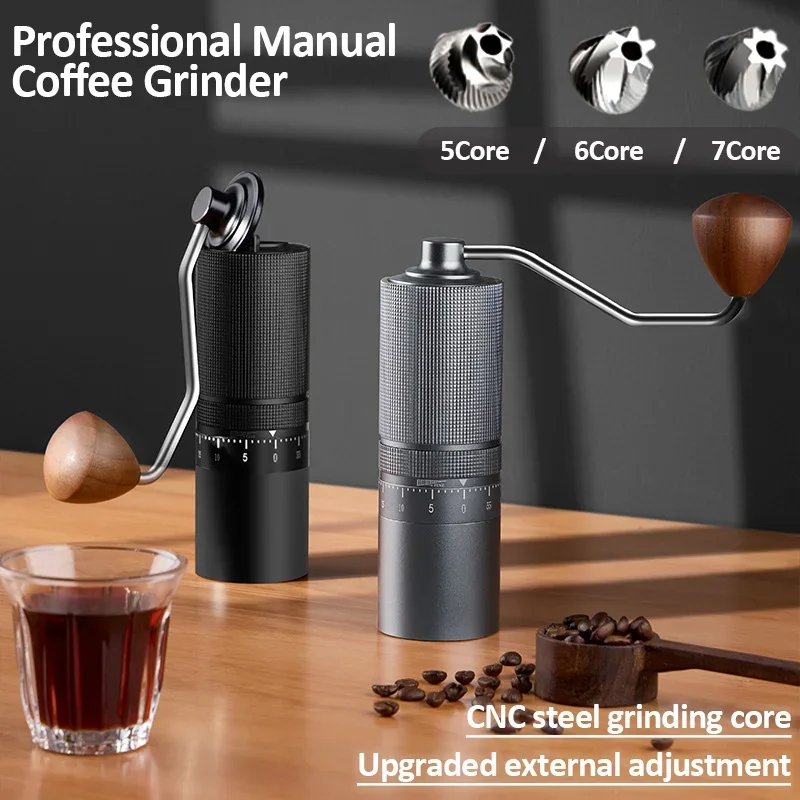
Cost-Value Analysis: Investment vs Performance
Manual coffee grinders span a wide price range, with burr type being a significant factor in cost differences:
Entry Level ($30-$80)
– Primarily conical burrs
– Basic construction
– Acceptable performance for casual use
– Typically ceramic burrs at lower price points
– May lack precision adjustment
Mid-Range ($80-$200)
– Predominantly conical burrs
– Improved build quality and materials
– Better grind consistency
– Enhanced adjustment mechanisms
– Steel burrs become more common
Premium ($200-$350)
– High-end conical and entry-level flat burrs
– Excellent build quality
– Superior grind consistency
– Precision adjustment systems
– Professional-grade burr materials
Ultra-Premium ($350+)
– Advanced flat burr designs
– Specialized conical burrs
– Engineering-focused construction
– Maximum grind consistency
– Exceptional materials throughout
Flat burr manual grinders typically cost more because:
– Manufacturing precision requirements are higher
– Engineering challenges for manual operation are greater
– Production volumes are lower
– Target market is specialty coffee enthusiasts
The value proposition depends on your coffee preferences and budget. For casual brewers using standard brewing methods, quality conical burr grinders provide excellent performance at moderate prices. For those seeking maximum extraction precision or specialized in pour-over methods, premium flat burr grinders may justify their higher cost.
Coffee enthusiasts pursuing the unique benefits of manual coffee grinders with stainless steel flat burrs should expect to make a significant investment for quality performance.
Why Are Conical Burrs Dominant in the Manual Grinder Market?
The prevalence of conical burrs in manual grinders stems from several practical factors:
Physical Efficiency
– Lower torque requirements make manual operation more comfortable
– Vertical grinding path works naturally with gravity
– Beans feed continuously without assistance
Manufacturing Practicality
– Conical design better accommodates compact grinder bodies
– Manufacturing precision requirements, while still high, are more forgiving
– Wider range of workable designs for portable applications
Historical Development
– Traditional hand grinders used conical designs for centuries
– Modern manual grinders evolved from these established patterns
– Market familiarity reinforced continued development
Consumer Experience
– Easier grinding experience increased consumer satisfaction
– More affordable manufacturing enabled broader market access
– Established market preference created continued demand
This dominance created a self-reinforcing cycle: more conical burr grinders led to more refinement of those designs, which improved their performance, which reinforced their market dominance.
Recent innovations, however, are challenging this pattern. Advanced bearing systems, improved mechanical advantage through gearing, and specialized burr geometries are making flat burr manual grinders more practical for daily use.
The general hand coffee grinder category continues to be dominated by conical burrs because they balance performance with user comfort for most brewing methods.
Can Flat Burrs Excel in Manual Grinders? Recent Innovations
Traditionally, flat burrs were considered impractical for manual grinders due to their higher torque requirements and horizontal grinding path. However, recent engineering advances have challenged this conventional wisdom:
Innovative Bearing Systems
– Precision bearings reduce friction during grinding
– Stabilized axles prevent wobble that increases resistance
– Double-bearing systems maintain perfect alignment under pressure
Mechanical Advantage Designs
– Extended handles provide greater leverage
– Gearing mechanisms multiply applied force
– Optimized handle rotation paths maximize efficiency
Advanced Burr Geometries
– Specialized cutting teeth patterns reduce resistance
– Improved bean-breaking chambers require less initial force
– Optimized particle flow paths minimize clogging
Materials Science Applications
– Surface treatments reduce friction between burrs
– Lightweight, high-strength materials maintain rigidity while reducing mass
– Specialized metals improve cutting performance without increasing weight
These innovations have created a new category of premium manual grinders that offer flat burr performance without requiring excessive physical effort. While they typically command higher prices than conical alternatives, they provide unique benefits for coffee enthusiasts seeking maximum extraction consistency.
The development of compact flat burr grinders represents a significant advancement in manual coffee grinding technology, offering previously unavailable grind profiles in portable formats.
Making Your Decision: Which Burr Type Is Right For You?
Finding your ideal manual grinder involves honestly assessing your brewing preferences and priorities. Consider these questions to guide your decision:
What brewing methods do you primarily use?
– Pour-over specialists may prefer flat burrs for clarity
– Espresso enthusiasts might choose conical burrs for body and crema
– Those using multiple methods might prioritize versatility
What flavor characteristics do you value most?
– If you prize bright, distinct flavor notes, flat burrs may be preferable
– If you enjoy rich body and traditional coffee character, conical burrs might suit better
How important is grinding effort to you?
– For daily grinding with minimal effort, conical burrs are typically easier
– If you’re willing to apply more force for specific grind characteristics, flat burrs expand your options
What’s your budget?
– Quality conical burr grinders start around $100
– Flat burr manual grinders typically begin around $250
How important is portability?
– Compact travel needs often favor conical burr designs
– Home use without travel needs opens up larger flat burr options
User Profiles:
For the outdoor enthusiast brewing AeroPress while camping, a compact conical burr grinder offers the best balance of performance and portability.
For the specialty coffee enthusiast focused on pour-over brewing, a premium flat burr grinder might be worth the investment for enhanced clarity.
For someone new to specialty coffee, a quality conical burr grinder provides excellent performance across brewing methods at a moderate price point.
Remember that personal preference ultimately matters more than technical specifications. The “best” grinder is the one that fits your specific needs and creates coffee you enjoy drinking.
For those prioritizing travel-friendly options, manual coffee grinders for portable perfection offer specialized designs, while portable coffee grinders provide various options balancing size with performance.
Common Myths About Burr Types in Manual Grinders
The coffee world is filled with strong opinions that sometimes become oversimplified myths. Let’s address some common misconceptions:
MYTH: “Flat burrs are always superior to conical burrs.”
FACT: Neither burr type is universally superior. They create different grind profiles suitable for different brewing methods and taste preferences. Quality and engineering matter more than burr shape alone.
MYTH: “Conical burrs can’t produce consistent grounds.”
FACT: High-quality conical burrs produce extremely consistent grounds with a characteristic bimodal distribution. This distribution isn’t a flaw but a different profile with its own advantages.
MYTH: “Flat burrs are only suitable for espresso.”
FACT: While flat burrs excel for espresso, they’re equally valuable for pour-over methods where clarity highlights origin characteristics. They’re versatile across brewing methods.
MYTH: “Ceramic burrs stay sharper longer than steel.”
FACT: While ceramic burrs maintain their edge slightly longer, modern steel burrs last for years of home use before showing noticeable wear. Both materials provide excellent longevity with proper care.
MYTH: “Manual grinders can’t compete with electric ones.”
FACT: Premium manual grinders often feature the same burr sets as electric grinders costing much more. Without motor noise and heat, many manual grinders actually outperform similarly priced electric models.
MYTH: “Flat burrs always have higher retention.”
FACT: While traditional flat burr designs retained more grounds, modern engineering has created low-retention flat burr systems that minimize waste.
Basing your purchase decision on accurate information rather than common myths ensures you’ll find a grinder that truly meets your needs.
Beyond Burr Shape: Other Factors That Matter in Manual Grinders
While burr shape significantly impacts grinding performance, several other factors contribute to the overall experience:
Burr Material Quality
– Premium steel alloys maintain sharpness longer
– Precision manufacturing tolerances affect consistency
– Burr coating can reduce sticking and static
Bearing System
– Dual bearing systems stabilize the central shaft
– Quality bearings reduce wobble during grinding
– Proper lubrication affects smoothness of operation
Adjustment Mechanism
– Click-based systems provide repeatable settings
– Stepless designs offer infinite adjustment precision
– Calibration systems ensure consistent zero points
Structural Stability
– Rigid frames prevent flexing during grinding
– Secure connections eliminate wobble
– Material choices affect weight and durability
Handle Design
– Length affects mechanical advantage
– Ergonomic grips reduce hand fatigue
– Foldable designs improve portability
Catch Cup Design
– Anti-static materials reduce grounds clinging
– Proper capacity matches typical brewing amounts
– Easy attachment mechanisms prevent accidental separation
These factors affecting grind consistency can sometimes matter more than burr shape itself. A premium conical burr grinder with excellent bearings may outperform a budget flat burr grinder with inferior construction. Quality all-metal hand grinders typically offer better stability and longevity compared to those with plastic components.
The Manual Grinding Experience: Embracing the Ritual
Beyond technical specifications and flavor profiles, manual grinding offers something increasingly rare in our modern world: a mindful moment of connection with your coffee preparation process.
There’s something deeply satisfying about the physical involvement in transforming whole beans into fresh grounds. The rhythm of turning the handle, the aroma of freshly crushed beans, and the visual transformation all engage your senses in ways automatic grinders cannot.
This ritual creates a moment of mindfulness – a brief pause in busy routines to focus on a single, simple task. Many coffee enthusiasts find this process meditative, an opportunity to prepare mentally for the day ahead or transition between work and relaxation.
Manual grinders also offer practical advantages beyond the experience:
– They operate silently, allowing early morning brewing without disturbing others
– They require no electricity, perfect for travel or outdoor use
– They typically last for decades with minimal maintenance
– Their mechanical simplicity means fewer components that can fail
Whether you choose flat or conical burrs, the act of manual grinding connects you to coffee traditions spanning centuries. The grinder becomes not just a tool but an expression of your commitment to quality and your personal coffee ritual.
For those wondering about the physical aspects, manual coffee grinders aren’t as hard to use as many expect, especially with modern engineering improvements.
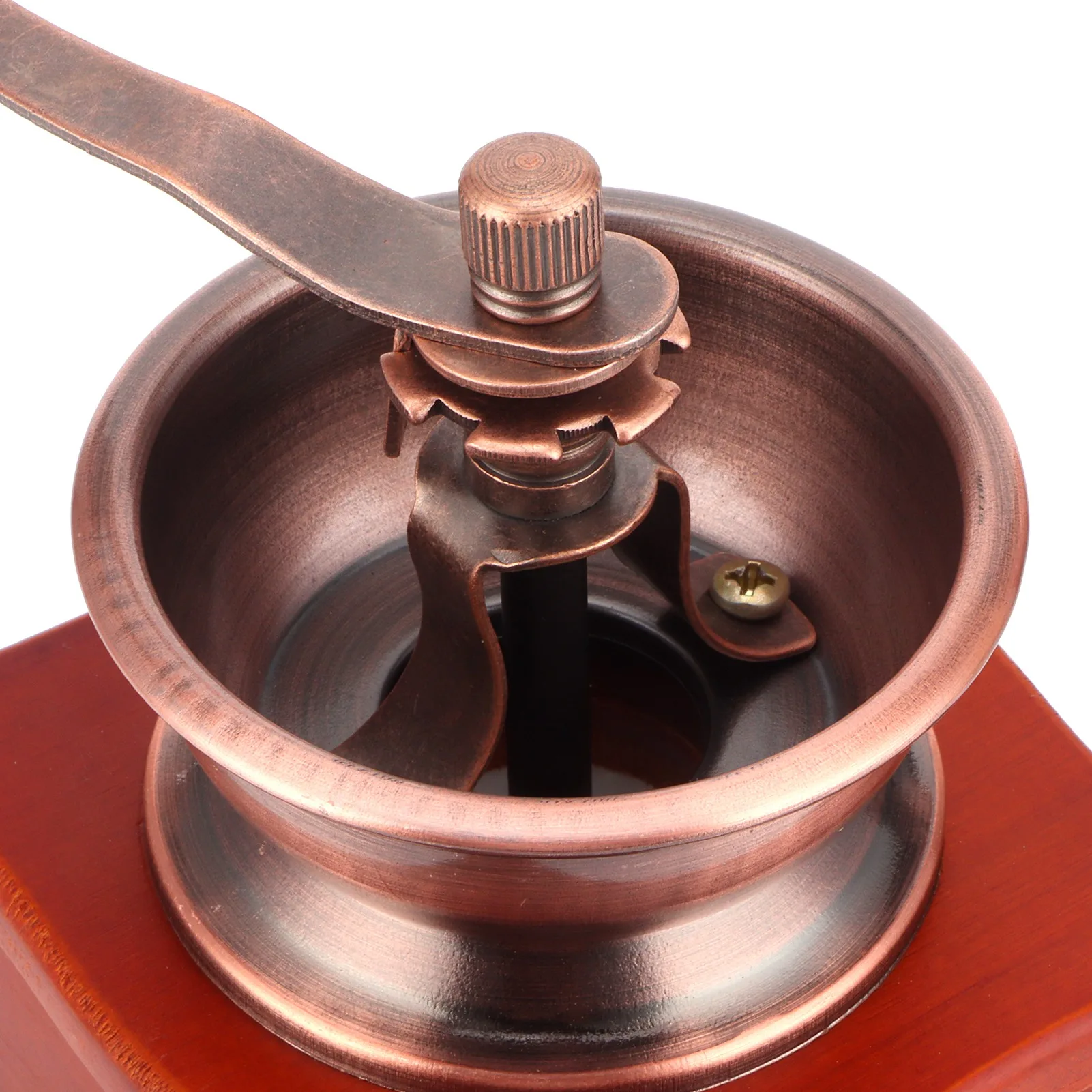
At Savor Suite, we believe the journey to exceptional coffee includes understanding your tools and their impact on your brewing process. Whether you choose flat or conical burrs, the perfect manual grinder awaits to elevate your daily coffee ritual.

